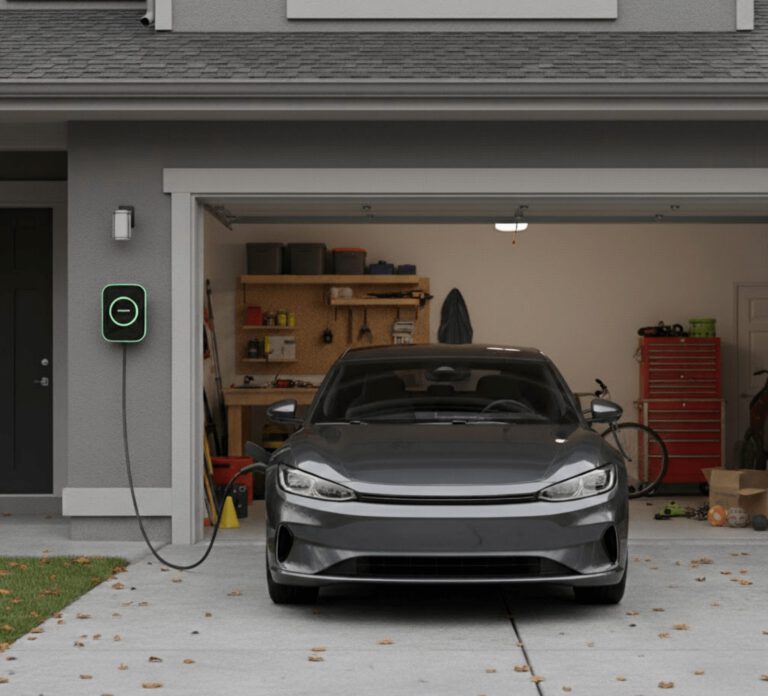Vehicle-to-Grid (V2G): Tech & Talent
A LOOK AT SOME OF THE TALENT REQUIREMENTS NEEDED TO ADDRESS THE CHALLENGES POSED BY THE NEW TECH

No longer just a mode of transport, the EV is becoming an active, intelligent asset for our energy infrastructure through Vehicle-to-Grid (V2G) technology. By enabling bidirectional energy flow, V2G allows EVs to not only draw power from the grid but also to supply it back, creating a flexible, distributed energy storage network. In today’s post, we are going to look at some of the skills needed to support the growth of this dynamic industry, as well as some of the challenges that lie ahead.
From Niche Concept to Commercial Reality
V2G has rapidly progressed from theoretical pilot projects to a tangible market opportunity. This transition is driven by two key factors: automotive industry integration and technical standardization. Major automakers are now engineering bidirectional capabilities into their new vehicle platforms. Simultaneously, the adoption of communication protocols like ISO 15118 is creating a universal language for vehicles, chargers, and grid operators to interact seamlessly and securely. As the global EV fleet expands and the share of intermittent renewable energy sources increases, V2G offers a smart solution for grid balancing and stability. Market projections indicate the V2G sector will expand into a multi-billion-dollar industry by 2030, creating significant demand for skilled professionals.
Building the V2G Workforce: Key Skills in Demand
Unlocking the full potential of V2G requires a workforce with a unique blend of expertise. The following skillsets are becoming essential for careers in this dynamic field:
-
Power Systems Engineering: Expertise in power electronics, grid interconnection standards, and the design of bidirectional charging hardware is fundamental to developing the physical infrastructure of V2G.
-
Software & Embedded Systems: Proficiency in developing the firmware and control software for V2G systems is critical. This includes mastery of communication protocols and the creation of aggregation platforms that manage energy flow from thousands of vehicles.
-
Data Science & Analytics: The ability to leverage machine learning and AI to forecast energy demand, analyze driver behavior, and optimize charging and discharging cycles for maximum economic and grid benefit.
-
Cybersecurity: Specialized skills are required to secure the communication networks between vehicles, chargers, and the grid, protecting critical energy infrastructure from potential threats.
-
Energy Market & Policy: A strong understanding of electricity market structures, ancillary services, and regulatory frameworks is necessary to develop viable V2G business models and navigate the complex policy landscape.
Navigating the Roadblocks to Widespread V2G Adoption
The path to widespread adoption is not without its complexities, however. A realistic assessment requires acknowledging the challenges associated with the safety considerations inherent in this transformative technology.
-
Battery Degradation and Longevity Concerns: For many EV owners, the vehicle’s battery is its most valuable component. A primary concern is whether the additional charge and discharge cycles inherent in V2G operations will accelerate battery degradation, thereby shortening its useful life and impacting the vehicle’s resale value. While advanced Battery Management Systems (BMS) are designed to optimize cycling and minimize stress, long-term empirical data is still being gathered, and transparent warranties from manufacturers will be crucial for consumer confidence.
-
High Upfront Infrastructure Costs: The implementation of V2G necessitates a bidirectional charging station, which typically carries a significantly higher price tag than a standard Level 2 EV charger. This substantial initial investment can be a barrier for individual consumers and fleet operators, despite the potential for long-term financial returns through energy arbitrage or grid service payments. Reducing these hardware costs through technological advancements and government incentives will be vital.
-
Interoperability and Standardization Hurdles: The effectiveness of V2G relies on seamless communication and functionality across a diverse ecosystem of vehicles, charging equipment, and utility systems. While the ISO 15118 standard is an important step towards universal communication, its full and consistent implementation across all manufacturers and infrastructure providers is still in progress. Inconsistent standards can lead to compatibility issues, limiting scalability and consumer choice.
-
Evolving Regulatory and Market Frameworks: Integrating EVs into the existing, often complex, energy markets requires significant regulatory evolution. Governments and utilities will be required to establish clear policies, fair compensation mechanisms, interconnection rules, and market structures that adequately value the grid services provided by V2G participants. This is not an easy task, and the slow pace of regulatory change in some jurisdictions will impede technological deployment and market growth.
Prioritizing Safety: A Foundation for Trust and Resilience
Beyond the operational challenges, the integration of V2G into homes and national grids also introduces critical safety considerations. Here are some:
-
Robust Cybersecurity Protocols: The interconnected nature of V2G systems makes them potential targets for cyberattacks. A compromised V2G network could allow malicious actors to disrupt grid operations by simultaneously commanding thousands of vehicles to charge or discharge, potentially leading to instability or blackouts. Safeguarding sensitive personal data related to vehicle usage and energy consumption is also a concern. Comprehensive, multi-layered cybersecurity measures, including advanced encryption, secure authentication, and real-time threat detection, are essential for implementation.
-
Electrical Safety and Grid Isolation: The bidirectional flow of high-voltage electricity between a vehicle, a home, and the utility grid demands stringent electrical safety measures. A fundamental requirement is “anti-islanding” protection. This critical safety feature ensures that if the main power grid experiences an outage, the V2G system automatically disconnects from the utility lines. This prevents the EV from inadvertently feeding power into “dead” grid sections, thereby protecting utility workers from electrocution during maintenance or repairs.
-
Advanced Battery Health and Thermal Management: With increased cycling from V2G operations, the risk of thermal runaway or other battery-related incidents could theoretically increase if not properly managed. Advanced Battery Management Systems (BMS) are important here, constantly monitoring cell voltage, temperature, and current. These systems must be engineered with sophisticated algorithms to prioritize the battery’s health and safety, preventing conditions that could lead to overheating, overcharging, or over-discharging, which could otherwise pose fire risks or significantly damage the battery.
